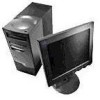IBM 6868 User Guide - Page 119
POST beep codes, number of beeps.
 |
UPC - 087944494911
View all IBM 6868 manuals
Add to My Manuals
Save this manual to your list of manuals |
Page 119 highlights
POST beep codes One beep and the appearance of text on the monitor indicate successful completion of POST. More than one beep indicates that POST detected an error. Beep codes are sounded in a series of two or three sets of beeps. The duration of each beep is constant, but the pattern of beeps and pauses between the beeps varies. For example, a 1-2-4 beep code sounds like one beep, a pause, two consecutive beeps, another pause, and four more consecutive beeps. For the following beep codes, the numbers indicate the sequence and number of beeps. For example, a "2-3-2" error symptom (a burst of two beeps, three beeps, then two beeps) indicates a memory-module problem. If you hear a series of beeps, have the computer serviced. Note: Depending on your computer, you might hear beep codes that are not in the following table. Beep code 1-1-3 1-1-4 1-2-1 1-2-2 1-2-3 1-2-4 1-3-1 1-3-2 2-1-1 2-1-2 2-1-3 2-1-4 2-2-2 2-3-2 2-3-3 3-1-1 3-1-2 3-1-4 Probable cause CMOS write/read failure BIOS ROM checksum failure Programmable interval-timer test failure DMA initialization failure DMA page register write/read test failure RAM refresh verification failure Memory failure or too many devices on RIMMs First 64 KB RAM parity test failure or too many devices on RIMMs Secondary DMA register test in progress or failure Primary DMA register test in progress or failure Primary interrupt mask register test failure Secondary interrupt mask register test failure Keyboard controller test failure Screen memory test in progress or failure Screen retrace tests in progress or failure Timer tick interrupt test failure Interval timer channel 2 test failure Time-of-day clock test failure Chapter 6. Troubleshooting 105















